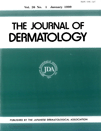A Case of Unna-Thost Disease Accompained by Epidermophyton floccosum Infection
Abstract
We report herein a case of 61-year-old man with Unna-Thost disease (nonepidermolytic hereditary palmoplantar keratoderma) who had been suffering from refractory dermatophyte infection. Diffuse palmoplantar hyperkeratosis developed in his infancy. Coarse scaling, fissures, marked erythema, and nail deformities appeared in his early adult life. Microscopic examination revealed fungal elements in scales and nail particles. Cultures of those scales isolated Epidermophyton floccosum. Genealogical study demonstrated that his mother, sister, brother, daughter, and niece had had similar tylosis, and all of the affected individuals except his daughter had been proved to have E. floccosum or Trichophyton rubrum infection. Oral itraconazole (100mg/day) was highly effective in treating his dermatophytosis without any adverse effects. Scaling, fissures and underlying erythema disappeared within four months.




